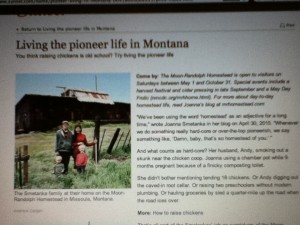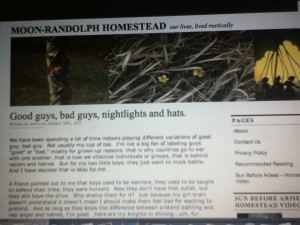It is my pleasure to introduce you to the Moon-Randolph Homestead. The property itself is located a mere 2 miles from downtown Missoula, Montana and stretches 170 acres. The history behind the property dates back to 1889 when the Moon family originally homesteaded the land. Over the last hundred plus years the land passed to various family members and has been home to cattle, chickens, hogs, cherry and apple trees, and various vegetables. The City of Missoula purchased the Moon-Randolph property in 1996 to preserve the open space for plants, animals and people alike.
In 1998 the North Missoula Community Development Corporation (NMCDC) embarked on a mission to save the northwest corner of the homestead, the location that encompassed the buildings that had been built or maintained by the Moon and Randolph families. The campaign to preserve the homestead was successful and in 2000 the NMCDC and the City of Missoula Parks and Recreation have managed the property through a cooperative agreement.
Today visitors, senior citizens to elementary children on field trips are able to experience the Moon-Randolph Homestead and find out what it was like to live the pioneer life. This is not thanks to an employee who has a 9am-5pm shift. It is thanks to the Smetankas family; who live on and care for the homestead. A Sunset Magazine article explains, “In exchange for living rent-free in a converted chicken coop, the Smetankas care for the land and livestock; maintain the buildings, including the original 1889 Moon cabin; coordinate a Maypole party and harvest festival; and greet visitors every summer Saturday.” This is all in addition to their day jobs. Andy Smetankas is a free-lance writer and teaches in Missoula and Joanna Smetankas co-owns a children’s clothing store also in town. Speaking of children, did I mention they have two boys Asa and Axel?
Per the Smetankas’s agreement with the NMCDC while living on the homestead they are to “value the homestead as a cultural landscape where active stewardship co-exists with layers of human and natural history.” However, they go above and beyond this and share with everyone who has access to the Internet as they blog (Moon-Randolph Homestead Blog) and create YouTube videos of their experiences while living on the homestead. While they have electricity and a computer, the modern amenities stop about there. The whole family shares a “family bedroom” and there is no modern plumbing.
Sun Before Arises–Moon-Randolph Homestead YouTube Video
The Moon-Randolph Homestead has even inspired a new take on language for the Smetankas. Joanna explains on her blog “We’ve been using the word ‘homestead’ as an adjective for a long time. Whenever we do something really hard-core or over-the-top pioneerish, we say something like ‘Damn, baby, that’s so homestead of you.” Their Top 10 hard-core moments include Andy smoking out a skunk near the chicken coop/house and Joanna squatting to pee into a chamber pot at nine months pregnant—“like, thirty times a day.”
While the Smetankas family live life rustically, they don’t do it alone. Come spring they enlist countless numbers of more than willing volunteers to help them plant gardens, take care of livestock, and maintain buildings. All the while these volunteers and visitors who come on summer Saturdays get to interact with the history, culture, and environment of the Montana landscape. The public is an essential piece to the sustainability of the Moon-Randolph Homestead. Not only do they visit and volunteer, private donations from the public are the homestead’s lifeblood.
The Moon-Randolph Homestead serves as an example of what can be done in the Inter-Mountain West in persevering the quickly depleting pre-Great Depression agricultural landscape. The way in which people once lived is becoming something one reads in a textbook rather than something you experience first hand. The Moon-Randolph Homestead is an excellent model of what could be done in Boise with the Pearl Jensen Farm Property off of Lake Hazel Road. Not only could it serve as a symbol of the pioneering spirit of Boise’s past, but by embracing current technology like blogging, social media, and mobile applications it can cement its place in the future. Who knows, you could even start uttering, “Damn, baby, that’s so homestead of you.”
Sources:
http://www.nmcdc.org/mrhhome.html
http://www.sunset.com/home/pioneer-living-in-montana-00418000068933/
http://www.facebook.com/pages/Moon-Randolph-Homestead/374267928824

I am not one for homesteading. I do not even like camping. But I think this is a great idea to get public involved in historical preservation. I believe historical preservation is difficult without the public interest. I think too often you have a building that is not be used because it is on a historical registrar or a piece of land with a “historical site” sign that everyone drives by. Having people who are willing to live and work the land like it was is a much better use of historical preservation. Great post! I’d love to visit, but probably not stay 😉
Wow, this is really fascinating! Restored or preserved homes get kind of mundane for me, but the idea of a family actually living the lifestyle of pioneers in the homestead makes the whole idea a lot more fascinating. I think our class should each volunteer a month of our lives to live in this manner at the Jensen house that you mentioned. I will even go first…but I am not sold on the chamber pot.
I read an article in the New York Times last fall about a couple who were resident caretakers at Ralph Waldo Emerson’s house in Concord, MA. They live there rent free for doing house cleaning and yard work and making sure the docents have access for giving tours. It’s seemed a nice way for a museum house that was seeing contributions decline to stay up and running. This Smetankas family has taken on an even more incredible commitment.
Sign me up! At least the Jensen’s had indoor plumbing. 🙂 The whole experience of this family living and working on the land is full of opportunities for public history projects. I don’t know if they grow heirloom seeds or not, but what a great way to show how people used to farm, and the variety of food they ate. Great project!
Very interesting, I liked your post. There was a series on PBS that focused on a similar setting, recreating time periods of the past. One is called Manor House, it is a reality style show that takes people from present time, and they must live as people lived during 1905, and must abide by Edwardian standards of behavior. Here is the link below.
http://www.pbs.org/manorhouse/theproject/making.html
I’ve also seen another series that focused on pioneer life, but I don’t remember the name of the show.
I built a cabin on our ranch up at Council that still lacks indoor plumbing so I can relate! I don’t use a chamber pot though, but do have a deluxe two seater outhouse that works just fine. We don’t get many skunks up in the mountains but I did have to dispatch two pack rats that moved in during my absence! I do believe that your project is useful to educate this younger generation of not only the difficulties of the the pioneer life, but more importantly the resourcefulness of those pioneers. Not to sound like my my old cynical grandpa but there is a serious lack of self sufficiency in this modern era!